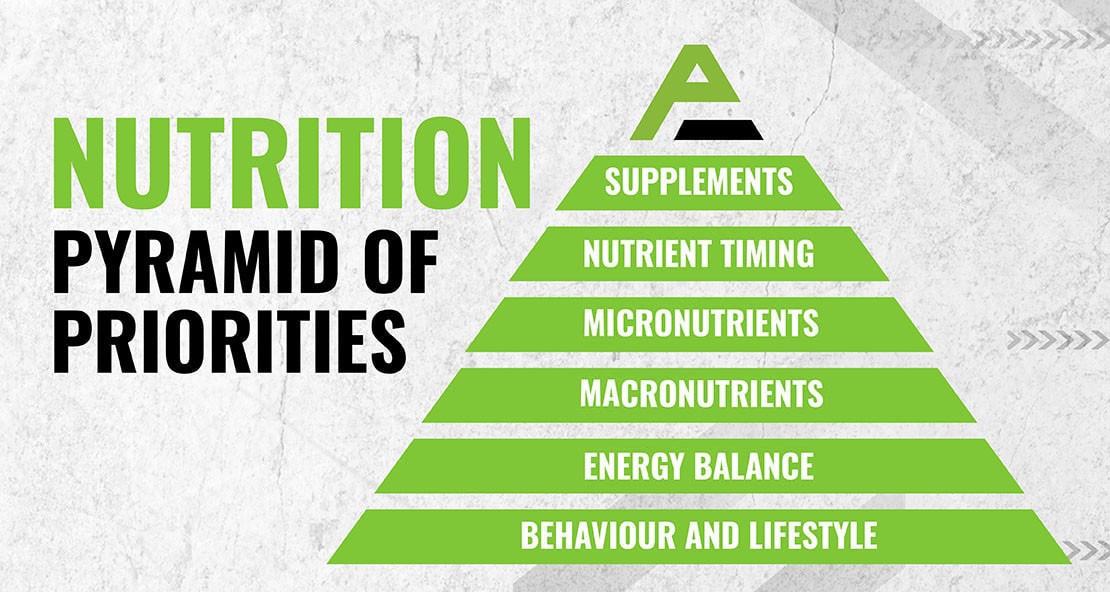Nutrition: Pyramid Of Priorities
Behaviour And Lifestyle
The foundation of the Pyramid of Priorities is behaviour and lifestyle. Building a nutrition plan upon shaky behaviour and lifestyle factors is unlikely to be successful. The most efficient, optimal nutrition program is destined to fail if it is not paired with a personalised approach that is based on good habits, lifestyle choices and behaviours. When producing a nutrition plan, it is important for individuals to consider how their lifestyle will be complemented by the protocols they are looking to adopt and how they should adapt their behaviours to make the plan sustainable and guarantee the results they desire.
Energy Balance
The next level on the pyramid is energy balance or caloric intake/expenditure. In terms of nutrition, calories refer to the energy that the body derives from food and drinks consumed. Different types of food contain different amounts of calories, with fats being the most calorie-dense at 9 calories per gram, followed by carbohydrates and protein at 4 calories per gram. The number of calories a person needs can vary depending on factors such as their age, sex, weight, height, and level of physical activity. Caloric intake and expenditure is the governor of weight loss, weight maintenance or weight gain.
- Calorie Deficit: Calorie Consumption < Calorie Expenditure
- Calorie Maintenance: Calorie Consumption = Calorie Expenditure
- Calorie Surplus; Calorie Consumption > Calorie Expenditure
Macronutrients
The next level of the pyramid includes macronutrients. Macronutrients are the three main types of nutrients that provide energy and make up the bulk of our diet: carbohydrates, proteins, and fats.
- Carbohydrates are the body's primary source of energy and include sugars, starches, and fibre.
- Proteins are important for growth, repair, and maintenance of tissues in the body. They are made up of amino acids.
- Fats are essential for many functions in the body, such as providing energy, insulating, and protecting organs, and helping to absorb certain vitamins.
Each of these macronutrients provides a different number of calories per gram. The amount of each macronutrient a person needs can vary depending on factors such as their age, sex, weight, height, and level of physical activity. A balanced diet typically includes a mix of all three macronutrients.
Micronutrients
The next level of the pyramid is micronutrients. Micronutrients are nutrients that the body requires in small amounts for proper growth, development, and functioning. Micronutrients include vitamins, minerals, and trace elements.
- Vitamins are organic compounds that the body needs for a variety of functions, such as growth, development, and immunity. There are two types of vitamins: fat-soluble vitamins (vitamins A, D, E, and K), which are stored in the body's fat tissues, and water-soluble vitamins (vitamins B and C), which are not stored in the body and need to be consumed regularly.
- Minerals are inorganic substances that the body needs for various functions, such as building strong bones and teeth, regulating fluid balance, and supporting nerve and muscle function. Some common minerals include calcium, iron, magnesium, and potassium.
- Trace elements are minerals that are required in very small amounts, typically less than 100 milligrams per day. These include chromium, copper, iodine, manganese, selenium, and zinc.
It is essential to maintain a balanced and varied diet to ensure adequate intake of all necessary micronutrients to prevent any deficiencies and to maintain optimal health.
Nutrient Timing
The next level of the pyramid is nutrient timing. Nutrient timing refers to the strategic timing of nutrient intake to optimize athletic performance, body composition, and recovery. The idea is that by consuming certain nutrients at specific times before, during, and after exercise, you can enhance your body's ability to build muscle and recover from exercise.
The basic principle of nutrient timing is to consume carbohydrates and protein before and after exercise, to fuel the workout and provide the necessary building blocks for muscle repair and growth. Furthermore, the timing of carbohydrate intake is also important, as consuming carbohydrates before exercise can help to provide energy for the workout, while consuming carbohydrates after exercise can help to replenish glycogen stores and facilitate recovery.
Supplementation
The top of the pyramid consists of supplementation. Supplementation refers to the act of adding extra nutrients, vitamins, minerals, or other substances to one's diet, usually in the form of pills, capsules, powders, or liquids. The goal of supplementation is to increase the intake of specific nutrients that may be lacking in one's diet or to enhance overall health and wellness. Whilst supplementation can be utilised to improve performance it's important to note that while supplements can be beneficial for some people, they should never be used as a replacement for a healthy diet and lifestyle.
Overall, the Nutrition Pyramid of Priorities emphasizes the importance of a balanced diet that includes a variety of whole foods and emphasizes the importance of consuming the right amount of calories, macronutrients, and micronutrients for optimal health.


